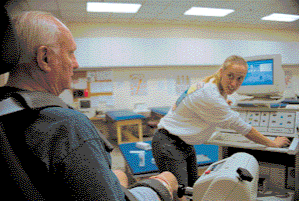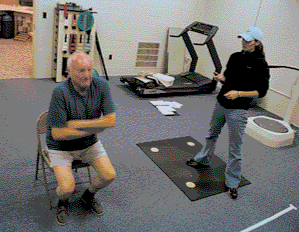As people age, the risk of a fall turning into a debilitating injury increases exponentially. Michael Godard, assistant professor of sports medicine, is doing something to help senior citizens stay steady on their feet.
Godard is heading a research project, based in the athletic training lab in Gorham, which uses feedback generated by sophisticated machinery to ultimately lead subjects to increased balance and stability. The subjects-eight so far-are all over 75, are not obese, and have no major musculoskeletal abnormalities. They volunteered to participate in the study, which is now in its eighth week.
“Sometimes individuals in this age range may never get out of a care facility if they fall,” Godard said. “We want to try and help people maintain their daily independent living status-not just physical activity, but social as well.”
The main focus of Godard’s study is to help seniors maintain a high quality of life for as long as possible. For the past several years, he has been focusing on the aging of skeletal muscles, and he now serves on the Wellness Committee with the Partnership for Healthy Aging. He recruited for this project with the assistance of Lifeline and the Osher Lifelong Learning Institute.
Subjects begin with an initial assessment to determine their strength and balance level, followed by three 20-minute visits per week for eight weeks. They are given a standardized physical activity questionnaire at various points throughout the training.
“Our goal is to determine if an increase in balance leads to an increase in physical activity,” said Godard. “Not only can we improve your stability, but what does this mean? Are you going to become more physically active?”
The clinical visits are spent mainly on the Biodex Balance System, which Godard describes as something like standing on a platform balanced on a ball. The platform is connected to a monitor that the subjects can see, and there are safety railings at hip-height around the machine. The subjects go through several sets of activities, including centering a dot in the middle of the screen (accomplished by balancing the platform), and moving a dot around the screen by shifting their weight.
“A lot of the clients talk to the machine,” said Samantha Whitman, research assistant to Godard. “They’re a riot. Some who were worse off were very concerned about improving their balance, even about standing up from a chair without using their hands.”

So far, the testing seems to be having positive results. Godard reports a 50-60 percent improvement in the subjects’ stability index, and is getting positive verbal feedback.
“It’s mostly good to hear that they feel they’re making improvements,” he said. Andrew Finger, a South Portland resident in his eighth week of the program, claims to be feeling a difference.
“I feel more secure, as far as fear of falling or in an emergency goes,” he said. “I’m amazed by the machinery, the computers and all that.”
Finger isn’t your average 75-plus, however. He works out at Lifeline six days a week, in a combination of aerobic and weight training. He joined Godard’s program out of interest more than need.
“As you get older, you begin to realize that if you fall, it could be a serious thing,” Finger said. “If the program helps me and eventually helps other people, that’s great.”
The program will continue throughout the spring, and Godard is accepting recruits. He can be contacted at 780-4698 for information.
Reference:
http://usmfreepress.org/2001/11/05/steady-on